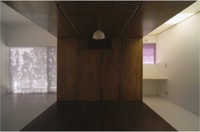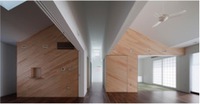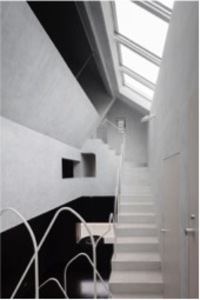リフレームされた空間 ―茜色の空間に託すもの A reframed space - the madder red room
リフレームされた空間
―茜色の空間に託すもの
敷地は千葉県外房勝浦の海から緩やかに上る傾斜地の上の方にある。傾斜地とは言っても角度は緩く絶景が広がるという場所ではない。別荘地として開発されたので一つ一つの敷地は広く協定で塀を禁止しているのでゆったりとした広がりのある住宅地という風にも見える。加えて東京からアクアラインを使えば2時間余りで来られるという利便性のせいで老後をこちらで生活するという定住者も多い。クライアントも既にリタイアして趣味の陶芸を千葉で、都会文化を東京で楽しむ、二拠点居住を考えこの建物を計画した。
クライアントの希望は、陶芸をするアトリエを作ること。車で寄り付いて雨に濡れず玄関とアトリエに入れること。外を見るための建物ではなく落ち着いた室内環境を生み出すこと。ベッドルームを3つ作ること。そのくらいだったと思う。こうした希望に対して我々は最初に3つの案を提示してそのうちの一つが選ばれた。それはほぼこの完成案に近いものだった。あまり迷いもなく間取りが決定されたのはまれなことである
この案の特徴は玄関を入ったところに大きなギャラリーがありこの場所を中心に動線が作られていることである。部屋を移動するときは概ねこのギャラリーを通過するように計画されている。このギャラリーは茜色をしている。この色は各部屋の折り上げにも使われておりあたかも夕焼けの光が差し込んでいるかのような感覚を生み出している。ギャラリーは壁も天井も茜色に染まり天井高も高くひときわ印象的な場所となっている。建物に入った時、部屋を移動するときにハッとして心を覚醒させる強さを持っているように思う。
こうした心の覚醒を建築や都市のデザインにおいて生み出したいという考えは独立して建築を作り始めた世紀の変わり目ころから持っていた。そして建築は建築という動かず毎日同じ姿を見せる物理的実体にも増して、建築以外のもの、例えば建築の外部における植物、人、空模様、内部ではペットや住人達に大きな力があるように思い始めた。そして建築はそうした建築以外の物を切り取るフレームのようなものではないかという仮説から「Architecture as Frame」(フレームとしての建築)という本を上梓した。その考えは今でも基本的には変わらない。しかしどうも自分の中には建築にも少しの力を期待している節がある。
直近の3つの住宅を思い返してみるとどの建物にもこの住宅と同様に部屋と部屋を移動するときに経由する場所にかなり強い印象を持った場所を作っているのである。もう少し抽象的に言えば空間の質の不連続性を作ることで建物を多様なものにしようとしてきたのである。
の不連続な空間をどのように形容したらいいのだろうか?建物全体は内外部に開かれ多様な関係性を持ったフレームのようなものではあるのだが、この不連続を形作るインビトゥイーンの空間それ自体はむしろある孤立した強い独立性を持っている。この家の重心として精神的な核となっている。つまり建築全体がフレームであるならばその中で再度強いフレーミングをしているのである。その意味でこれはリフレームされた空間と言えるであろう。
そこで直近3つのリフレームされた空間について簡単に説明しておこう。
1つ目は2009年に竣工した「高低の家」である。この建物は3種類の空間で構成される。トップライトから光が舞い降りる細い廊下空間(写真右)。それに繋がる天井が低く暗い空間(写真中央)。さらにそこにつながる天井の高い明るい空間である(写真左)。ここで3つの空間は異なる質を持ち不連続性を持ち中央の空間がリフレームされた空間となっている。
2つ目は2010年に竣工した「三廊下の家」である。この建物は名前の通り東西に3つの廊下があり3つの室と和室、書斎、居間、食堂、水回りがこの廊下によって接続されている。3つの廊下のうち中央のもの(写真中央)は天井も高く強い印象をもった空間となっている。ここでもこの中央の空間はリフレームされた空間と言えよう。
3つめは2013年に竣工した内の家である。この建物は四つの個室が白い吹き抜け空間の周りにまとわりつくように配置されており部屋の移動でこの白いボイドを通ることになる。この白いボイドは1階広間の黒い空間ともそれに続くグレーの個室空間とも異なる異質の空間でこの建築をリフレームしているのである。これら3つの建物のリフレームされた空間同様、本建物の中心にある茜色のギャラリーも同質のリフレームされた空間となっている。
4つのリフレームされた空間に共通することは建物全体コンセプトである「フレームとしての建築」が開かれたものであるのに対して、内省的な場と言えるであろう。
これからしばらくは建築以外と建築自体とのデュアルな力のバランスに建築を載せてみようと考えている。
高低の家 High and Low House 2009 A reframed space - the madder red room The site sits on a higher side of a hill that gently climbs up from the Pacific Ocean near Katsuura, located in a region called Sotobo (Outer Boso Peninsula) in Chiba prefecture. The slope is not steep enough to make it a spectacular lookout point. The area has been developed for vacation homes with spacious lots. The local rule prohibits the fences, which makes the whole area look like a comfortably stretched residential quarter. In addition, as it is under a three-hour drive from Tokyo via TokyoWan Aqua-line (Trans Tokyo bay Expressway), its convenience has attracted a considerable number of retired people who decided to spend their remaining lives over here. As for my client, he has already retired from work, is enjoying an urban cultural life in Tokyo, and spending his hobby time as a ceramist in Chiba. The house has been planned as his second home. The client didn’t ask too much: he wanted an atelier for his pottery making, a direct approach from his car to the entrance and his atelier without being wet in a rain, a calm inner environment rather than a good view, and three bedrooms. We offered 3 design plans, and he chose one which was very close to the finished design presented in this book. It was a rare experience that the client accepted our layout plan without much pondering. The key characteristic of the plan is that there is a large gallery next to the entrance, which is the hub of the traffic in the house. The plan has been made so that the residents frequently pass through this area when they move between the rooms. The entire gallery from the floor to the ceiling is painted in madder red which is also used on the coved ceiling of each room to create an effect as if the glow of sunset is filtering through the window. The gallery is especially impressive as the entire space is filled with madder red and the ceiling is very high. It has strong energy to refresh people’s senses when they enter the house or move between the rooms. I have had a desire to bring about the re-freshening of the senses to people by way of architecture and urban design since the time I became an independent architect around the turn of the century. After a while, I began to think that a piece of architecture is merely a fixed physical object that shows the same look every day, and there are more dominant non-architectural objects such as plants, people, and skies in outer environment, and the dwellers and the pets inside the architecture. I wondered if a piece of architecture is like an open frame which dominant non-architectural elements are unexpectedly and whimsically framed in to give fresh surprises to the residents’ lives. This hypothesis led me to write a book titled “Architecture as Frame”. The idea still hasn’t changed basically, but there is another side of me that recognizes that the architecture has some influential power. When reviewing each of the 3 houses I designed recently, I noticed that I had put a space that brings about a strong sensuous impact, just like the madder red gallery, in the hub area where the residents pass by when moving between the rooms. Putting it in an abstract way, I tried to give versatility to the architecture by creating discontinuity to the space. What descriptor should be given to this discontinuity? The house as a whole is like a frame, open to environments inside and outside, and maintaining various relationships with them. The space that creates the discontinuity, which sits in between the rooms, is isolated and independent from the other rooms, and acting as the center of gravity and the spiritual core of the house; if an entire house is a frame, it is re-framing the frame. Therefore, the space is a reframed space. Let me provide brief descriptions of the 3 recent cases of the reframed space. The first one is the “High Low House” completed in 2009. The house consists of 3 connected spaces of different types. The narrow corridor where lights pour down from the roof light (right side of the photo), the dark and low ceiling space (center of the photo), and the bright room with a high ceiling (left side of the photo). In this case, each space has distinctive character that creates discontinuity as a whole, and the space in the middle is the reframed space. The second case is the ‘Three Corridors House’ completed in 2010. It has, as the name indicates, 3 corridors that span from the east side to the west side of the house, connecting 3 bedrooms, a tatami room, a study, a living room, a dining room, and the wet areas. Among the three, the central one has a high ceiling and creates a strong impression, hence the reframed space in this house. The last one is the “House House” completed in 2013. 4 individual rooms are laid out closely around a white void, and the residents inevitably walk through here when moving between the rooms. The white void is distinct from the black-colored hall underneath and the grey bedrooms adjacent to it, reframing the house. Similar to the 3 spaces described here, the madder red gallery featured in this book, located in the center of the house, is also a reframed space. The common characteristic of the 4 reframed spaces is, contrary to the concept of the house of “Architecture as Frame” which indicates openness, it is the space for reflection. For the time being, I will try to balance the power of architecture itself and that of non-architectural things in my designing. 

三廊下の家 Three Corridors House 2011

